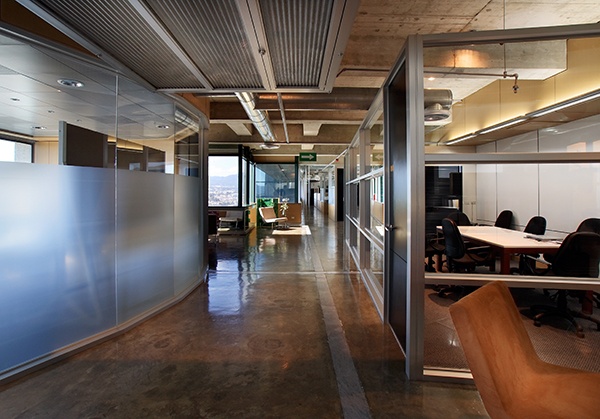
The bad news is that open office space is here to stay. The good news is that private offices are also here to stay. While the office design pendulum has swung in both directions over the past few decades, it appears to be finding a space closer to the center, offering opportunities for both collaboration and privacy.
The Two Extremes
Original models for offices leaned heavily towards providing private spaces. A typical office would be configured with a seeming labyrinth of private spaces and open areas for support and entry-level personnel. Mid-level employees would have small, interior spaces while senior management enjoyed large offices on corners with generous glass lines. Everyone else fell somewhere in the middle.
Private-heavy spaces fell out of favor in the 1970s. They were extremely space inefficient, and tended to stifle communication and collaboration while enhancing a sense of hierarchy. The solution was the cubicle. Invented in the 1960's by Herman Miller designer Robert Propst, these three-sided flexible offices offered the ability to offer some sense of privacy while also creating higher density and greater flexibility.
Some companies went a step farther, eliminating the cubicle walls. These truly open offices took the aesthetic of the trading floor and applied it to just about every conceivable type of work. Openness eliminated some of the sense of claustrophobia that came with cubicles, but it also doubled down on many of the drawbacks of the "cube farm." These spaces had less privacy, more interruptions and greater levels of worker discontent.
To mitigate these challenges, office space designers went to a hybrid model. Workspaces began to be designed with a range of environments. Collaboration spaces, calling booth, team rooms and just about every type of configuration all got thrown together into a mishmash, giving everyone the opportunity to find the space that they needed at the time they needed it.
Finding Privacy in Open Office Space
In these mishmash spaces, one throwback to an earlier age keeps popping up: the private office. While some private offices are designed for anyone to use on an as-needed basis, companies are also offering them to employees on a permanent basis, when appropriate.
Some companies like private office spaces because they still believe in hierarchy. Radical experiments in self-management, like Zappos' embrace of holacracy have had mixed results. Giving the boss a private office helps to remind employees where they can go for help, guidance and direction. Alternately, giving a highly successful worker an office can let that person serve as a highly visible role model of the benefits of hard work.
Private office space also enables workers to be more effective at focus-intensive tasks. Planning, programming, writing, analyzing and the like can all be easier to do when the worker can control interruptions and allow him or herself to concentrate. This is almost impossible to do in a cubicle. While flexible arrangements may allow everyone to get private space on an as-needed basis, assigning it to those who need it regularly can improve efficiency.
Some workers also need files and private spaces. Many regulations like Sarbanes-Oxley, HIPAA and the like require some materials to be kept in locked and controlled office space. Giving the workers who work with those materials their own space simply makes sense.
These are just a few of the reasons that companies and workers are rediscovering the many benefits of private office space. While it's unlikely that offices will return to the closed-off designs of the 1950s and 1960s, the private office will still remain for those who truly need it.
Take a look at some of these other great CRE articles:
7 Tools to Analyze Your Office Design
Four Office Space Expansion Strategies
Sense of Purpose and Your Next Office Space
Don't forget to subscribe to our blog!!








